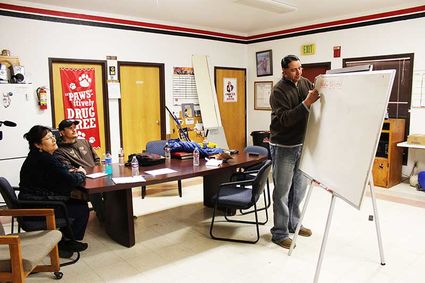Language is healing: Native language preservation at Fort Belknap
November 18, 2015

Steve Edwards
Linda Azure and Ray Cichosz listen as Terry Brockie teaches a native language community class at Fort Belknap Agency.
Ray Cichosz, Program Coordinator of Language Preservation, is responsible for organizing and promoting various activities and programs that work to preserve the native languages of the Gros Ventre (White Clay) and Assiniboine tribes at Fort Belknap. Native language classes are being offered at various locations in both languages. Classes recently began at three locations around Fort Belknap (see locations and times at end of this story).
Cichosz has been the Program Coordinator since May, 2014. He explained, "These community language classes are just part of our efforts to preserve our native languages. We also offer immersion camps-extended programs for adults and children that let participants learn about native foods, medicines and other aspects of their native cultures in a camp setting. There is currently a project to create a 'talking dictionary' that will use the latest technology to preserve the Fort Belknap languages and make access to learning the languages more comfortable to the younger generation.
Community language classes
Terry Brockie teaches the Aaniiinen (White Clay) community language classes. He also teaches college level native language classes at Aaniiih Nakoda College located at Fort Belknap Agency. Brockie said, "The students taking the community classes are varied and take the classes for a variety of reasons. I have two students in one of the classes who are taking the class as part of their work toward earning a Class 7 teaching license so they can teach native language classes in schools."
Brockie explained, "There are no college teacher certification programs in native languages. The Montana Office of Public Instruction created a certification program to qualify native language teachers. Each tribal government has a set of criteria that a prospective native language teacher must meet. When the person meets the criteria, they are issued a Class 7 license on the recommendation of their tribal government."

Brockie is familiar with the process as that is how he first became a native language teacher at Hays/Lodge Pole and the tribal college. He said, "I was asked to replace Elmer Main who was a native speaker and taught at the local tribal college. I worked with Theresa Lame Bull, who at the time was nearly 100 years old and an 'old time speaker'. Old time speakers are recognized by others as very proficient in their native language and experts in their language. I spent many hours learning from and speaking with her to learn the White Clay language."
There are already dictionaries of the White Clay language. Brockie and John Stiffarm will be working on the talking dictionary project, using a vocabulary from a spreadsheet and attaching an audio recording to the vocabulary.
"A major challenge with our language," Brockie added, "is that you can't simply translate word for word. The context of words and the broader cultural context helps give meaning to what a native speaker is trying to express. Our language is very descriptive and it's hard to translate simply using a dictionary or other vocabulary aid."
Linda Azure, who was also in the White Clay class, said she was taking the class "so I can say my prayers in my native tongue. My mother was a native speaker and I heard the language spoken. I didn't have enough time with her to learn it adequately. This class is very helpful and one of several I've taken over the years."
Brockie said, "In Linda's mother's generation there were more native speakers, now they are not many left. These classes are important to perpetuate our language."
Language is Healing
Organizers of the various preservation activities at Fort Belknap chose the theme: Language is Healing. They believe language is the key to preserving their history and culture, and they key to defining their future.
For Brockie, "Learning and speaking my native language helps explain all of me, who I am, my origins, my history, my spirituality, my very being. I can know some random native words but it's necessary to learn the language to get the essence of my culture. It's like 'connecting the dots' to explain our world and our place in it."
Language preservation is a daunting task, but Brockie is optimistic it is doable. He explained, "I compare native languages to the natural world-the keystone prairie predators like the wolf, the buffalo and the grizzly were all on the brink of extinction, now they are coming back. Our language survived many centuries, it didn't become extinct. My hope is it will continue to come back, like the keystone predators, and thrive again.
You can call the Language Preservation Office at 353-8355 for more information about native language classes at Fort Belknap. The 2015-2016 classes are being offered as follows:
• In Hays at Hays/Lodge Pole School: Tuesdays, Aaniiih and Wednesdays, Aaniiih and Nakoda, 6-7:30 p.m.
• At the Fort Belknap Agency, CDC Youth across from the Red Whip Center: Tuesdays and Thursdays, Aaniiih, Mondays and Wednesdays, Nakoda, 6:30-8 p.m.
• In Lodge Pole, at Medicine Bear, Mondays, Nakoda, 6-7:30 p.m.

